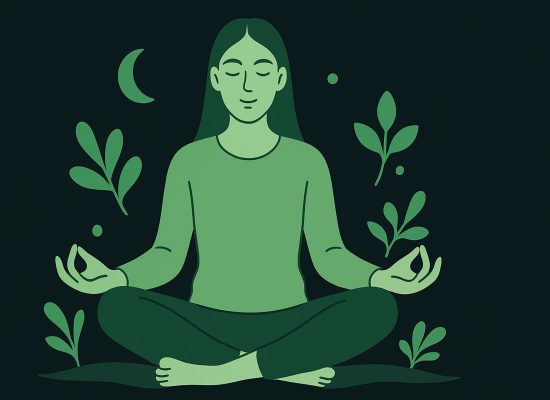In this article, we’ll debunk some of the most common meditation myths, giving you a fresh perspective on how meditation truly works and how it can fit into your life in a way that feels natural and accessible. Despite its growing popularity, meditation is often surrounded by misconceptions. Many believe it’s solely about sitting still or achieving a blank mind. However, these meditation myths can deter individuals from exploring practices that promote both energy and calmness. By debunking meditation myths, we aim to showcase how meditation can be a versatile tool, adaptable to various lifestyles and needs.
Table Of Content
- Challenge of Meditation Myths
- Meditation Myth 1: You Have to Sit Still
- Meditation Myth 2: You Need a Quiet Environment to Practice
- Meditation Myth 3: You Are Supposed to Have No Thoughts
- Meditation Myth 4: Meditation Is Just a Religious and Spiritual Practice
- Meditation Myth 5: Meditation is Only to Relax
- Meditation Myth 6: Meditation isn’t Useful Off the Mat
- Meditation Myth 7: Meditation Is Too Abstract
- Meditation Myth 8: Meditation Hasn’t Been Scientifically Proven
- Use Siddha Meditate to Experience the Benefits of Meditation
- FAQ about Debunk Meditation Myths
Challenge of Meditation Myths
Despite its growing popularity, meditation is often clouded by misconceptions that keep people from experiencing its full range of benefits. Many of us have heard meditation myths like “You must sit still to meditate” or “Meditation is only for relaxation.” But what if we told you that meditation can also boost energy, enhance focus, and help you stay grounded in everyday life? In this article, we’ll debunk meditation myths and show how meditation can be both calming and energizing, depending on the Whether it’s the belief that you have to sit perfectly still or completely quiet your mind, these myths create unnecessary barriers.
In this article, we’ll unravel some of the most common meditation myths and offer a fresh perspective on how this ancient practice can easily fit into your modern life—naturally, accessibly, and without the pressure of perfection. With the rise of meditation apps, overcoming these barriers has become easier than ever before.
Meditation Myth 1: You Have to Sit Still
If you picture a monk sitting perfectly still in an upright position every time you think of meditation, you’re not alone. A common misconception is that meditation requires sitting still—but that couldn’t be further from the truth! Meditation is meant to provide stress relief, not add to it. If you have trouble sitting still or suffer from back pain, don’t worry—there are plenty of alternatives.
It’s normal to feel some discomfort when you’re new to meditation. If you haven’t spent much time exploring your inner world, it might feel challenging at first. But we’re here to support you through the process. Here are three forms of moving meditation you can try:
- Walking meditation: Focus on your surroundings as you walk, paying attention to each step and being mindful of your breath. This helps ground you in the present moment.
- Yoga: Move your body mindfully in sync with your breath, cultivating awareness through physical movement and creating a deeper connection between mind and body.
- Ecstatic dance: Let go of the need to perform or think about your movements, and allow your body to guide you intuitively, helping you release mental chatter and get into your body.
These movement-based practices allow you to experience the benefits of meditation without needing to sit still. You can still cultivate mindfulness and connect with your body in ways that suit your needs.
Meditation Myth 2: You Need a Quiet Environment to Practice

Meditation doesn’t need to be done in complete silence. In today’s busy world, that’s often unrealistic. It’s better to aim for an imperfect yet consistent meditation practice than strive for a perfect one that feels unattainable. With meditation apps, you can practice anywhere—at home, during your commute, or on a break at work.
Here are two ways to handle distracting noises in your environment:
- Use noise-cancelling headphones: Block out distractions and take advantage of modern tech. With headphones and a meditation app, you can practice even on a noisy train during your commute.
- Incorporate the sounds around you: You can also use the sounds in your environment as part of your practice. Try Siddha Meditate’s Sound and Vibration Meditation, where external noises become a tool to bring you into the present moment. This practice helps build acceptance of your surroundings, a skill that translates to greater acceptance in daily life.
For more understanding on Meditation Myths, you can read “The Science Behind Meditation“
Meditation Myth 3: You Are Supposed to Have No Thoughts
Just like you don’t need a perfectly quiet external environment to meditate, you don’t need a silent mind either. One of the biggest myths about meditation is that if you’re thinking, you must be “bad” at it. Spoiler alert: you can’t be bad at meditation! The mind is designed to think—most people have around 60,000 thoughts per day. Those thoughts won’t suddenly disappear just because you get quiet and start paying attention to them.
In fact, the practice of meditation truly begins when you notice your thoughts. The goal is not to stop thinking, but to become aware of your thoughts so they have less control over you. As you develop this awareness, you can begin to choose which thoughts to engage with, helping you reduce anxiety and overthinking. Meditation empowers you to be more intentional with your thoughts, ultimately leading to a calmer, more mindful life.
Scientific research supports that meditation involves observing thoughts rather than eliminating them. Studies have shown that regular meditation can alter brain regions associated with emotional regulation and memory, enhancing one’s ability to manage thoughts and feelings effectively.
Meditation Myth 4: Meditation Is Just a Religious and Spiritual Practice
Meditation has become a widely used tool for enhancing both mental and physical well-being. While it originated in India as a practice of Hinduism, meditation has been thoroughly researched and embraced in the West by individuals and organizations aiming for self-improvement.
When the Buddha discovered meditation, it was practiced as a path to self-discovery and the alleviation of suffering. Today, we can apply it in our modern lives as a tool to better understand our minds and bodies, helping us make more intentional choices that reduce daily stress. As workplaces recognize the toll that stress has taken on their employees, companies like Google, Microsoft, and LinkedIn now offer mindfulness programs to their employees. Starting the day with mindfulness has been shown to significantly boost productivity while fostering greater presence and connection in personal life, enriching time spent with family and friends. Ultimately, meditation supports living a more balanced, joyful, and purpose-driven life.
Jon Kabat-Zinn at the University of Massachusetts Medical School is a well-known figure in the field of mindfulness meditation. In one of his best-selling books he said, “I like to think of mindfulness simply as the art of conscious living. You don’t have to be a Buddhist or a yogi to practice it… It is simply a practical way to be more in touch with the fullness of your being through a systematic process of self-observation, self-inquiry, and mindful action.”
Meditation apps like Siddha Meditate help you explore accessible and secular practices. Instead of focusing on abstract concepts like spiritual enlightenment, Siddha Meditate provides tangible goals and measurable results in your meditation practice.
If you are new to meditation, you can read “How To Meditate? Step by Step Guide for Beginners“
Meditation Myth 5: Meditation is Only to Relax
Although it is true that meditation is used to promote relaxation and reduce stress, that is not all it is used for. It can also be a tool to enhance focus, energy, emotional regulation, and creativity. Different types of meditation can offer these specific benefits:
- Focus & Productivity: Practicing mindfulness meditation can teach your mind to stay present. By focusing on one thing, like something in your surroundings, your breath, or sounds can help boost concentration throughout the day.
- Boosting Energy: Certain breathing techniques, like breath of fire, can stimulate the sympathetic nervous system and be used as a natural caffeine boost.
- Emotional Regulation: Emotional regulation meditations can help you become more resilient in the face of difficult emotions, teaching you to name your emotions and feel them in the moment.
- Creativity and Problem-Solving: Open-awareness meditation allows the mind to flow freely which can lead to creative breakthroughs.
Meditation for Energy vs Calmness: Which Practice Is Right for You?
People often assume that meditation is only meant to calm the mind, but certain meditation styles can actually increase energy levels and improve mental clarity. Whether you’re looking for meditation for energy to start your day or meditation for calmness to unwind, different techniques cater to different needs. Let’s explore how meditation can help you feel both energized and relaxed depending on your approach.
- Meditation for Energy: Practices like breath-focused meditations can stimulate the nervous system, providing a natural energy boost. Incorporating these into your routine can enhance alertness and vitality.
- Meditation for Calmness: Techniques such as mindfulness and progressive muscle relaxation are designed to activate the body’s relaxation response, reducing stress and promoting tranquility. Regular practice can lead to improved emotional regulation and a sense of inner peace.
Meditation Myth 6: Meditation isn’t Useful Off the Mat
Meditation isn’t just something you practice while sitting on your mat or at your desk, it’s a tool that is applicable to your everyday life by bringing awareness into everything you do. The true test of meditation happens when you are in a moment of stress or conflict and can respond more mindfully. Whether you establish a consistent mindfulness, breathwork, or affirmation practice, meditation offers many ways to enhance your day-to-day experience.
Have you ever considered that meditation can be practiced while doing household chores? With mindfulness, even mundane tasks like washing dishes can become opportunities to cultivate presence and awareness. This is called “putting meditation into action” — helping you complete tasks more efficiently while fostering a deeper sense of mindfulness.
For the days when you can’t schedule a formal meditation session, using daily tasks as a way to meditate is a great alternative. It can also help shift your mindset from ‘I have to do laundry’ to “I get to do laundry because I have a home and clean clothes.” Meditation encourages perspective shifts that foster gratitude and joy. You can start putting this into practice with the Mindfulness During Daily Chore meditation.
By staying consistent with a tool-based practice, you can integrate meditation seamlessly into your life—whether by scheduling time on your calendar, using it on the go, or applying it in moments of frustration. The benefits are far-reaching, enhancing both your productivity and emotional well-being.

Meditation Myth 7: Meditation Is Too Abstract
Meditation can feel elusive or hard to grasp, especially without proper guidance. However, with the use of meditation apps, the practice has become far more accessible and grounded in real-world results. Apps provide structured programs, guided sessions, and progress trackers, offering step-by-step instructions that take the guesswork out of meditation. Whether you’re a beginner or experienced, these tools tailor the practice to your current needs, offering timed sessions with guaranteed results. With Siddha Meditate, you can use your calendar to schedule out your weekly meditations and stay consistent on your meditation journey.
While you might experience immediate benefits like stress relief after just one session, larger improvements in areas like focus, emotional regulation, and overall well-being typically take more consistent effort. Research shows that practicing meditation 5-7 days a week for 5-10 minutes can yield noticeable results within 8-12 weeks. Just like going to the gym to build physical strength, meditation trains your mental muscle. The more you practice, the more tangible your results become.
Meditation isn’t just for those aiming for spiritual enlightenment —it’s a practical, daily tool for everyone. Whether it’s managing stress, increasing focus, or improving emotional well-being, meditation can help you navigate modern life with more ease and clarity.
Meditation Myth 8: Meditation Hasn’t Been Scientifically Proven
Many people wonder, is there any evidence of the effects of meditation? Does meditation really work? The answer is yes! Meditation has been scientifically proven by many well-known institutions like Harvard and John Hopkins with thousands of peer reviewed studies.
The Wharton Neuroscience Initiative explains the effects discovered from neuroimaging studies of meditators vs non-meditators brains. This is what neuroscience is telling us:
- Meditation engages and and trains metacognitive awareness in the pre-frontal cortex, helping with higher order thinking and processing of information.
- Long-term meditators have higher pain tolerance and and more body awareness.
- Meditators have structural changes in their hippocampus, supporting memory, emotional learning, and stress reduction
- Meditators show enhanced activation of the anterior cingulate cortex to support problem-solving and self-control.

Use Siddha Meditate to Experience the Benefits of Meditation
By understanding and debunking meditation myths, you can tailor your practice to suit your personal goals, whether it’s achieving a state of calm or boosting your energy levels. Explore various meditation techniques to discover what resonates best with you, and consider integrating them into your daily routine for holistic well-being.
Siddha Meditation can help achieve the benefits of meditation in tangible ways, without getting trapped in these meditation myths. Visit the Siddha Meditate page to begin your meditation journey and start syncing meditations to your calendar to plan for the week ahead.
FAQ about Debunk Meditation Myths
1. Can meditation help increase my energy levels?
Absolutely. Certain meditation techniques are designed to invigorate the mind and body, providing a natural energy boost without relying on external stimulants.
2. Is it normal to have thoughts during meditation?
Yes, it’s entirely normal. The goal of meditation is not to suppress thoughts but to observe them without attachment, fostering a more mindful and present state.
3. Do I need a quiet environment to meditate effectively?
While a quiet space can be beneficial, it’s not essential. Meditation can be practiced in various settings, and learning to find calm amidst noise can enhance resilience and focus.
4. Is meditation a religious practice?
Although meditation has roots in spiritual traditions, it is widely practiced today as a secular activity aimed at improving mental and physical well-being.
5. What is the difference between meditation for energy vs. meditation for calmness?
Meditation for energy uses techniques like breathwork, visualization, and movement-based mindfulness to activate the nervous system and enhance alertness. In contrast, meditation for calmness focuses on deep breathing, progressive relaxation, and body awareness to quiet the mind and relieve stress. Choosing the right practice depends on whether you need a boost of mental clarity or a moment of deep relaxation.







